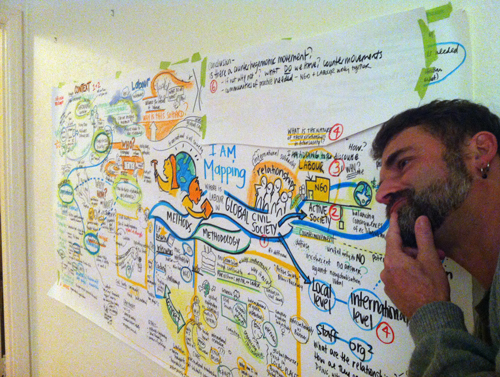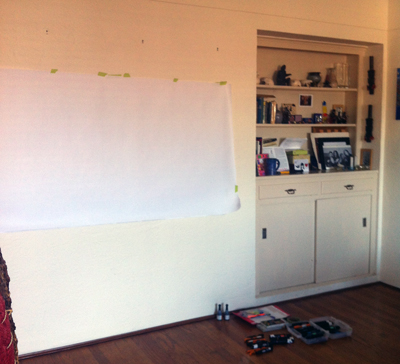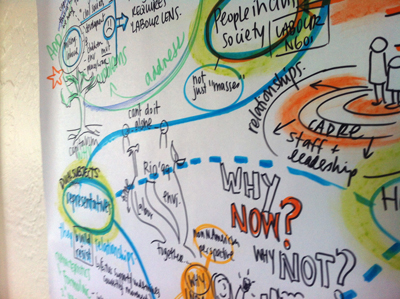Using graphic facilitation for writer’s block

At some point in writing a PhD, it’s safe to say you’re going to get writer’s block. Wouldn’t anyone?
So when an old, trusted friend was stuck in his writing process, I asked him to experiment with me: could graphic facilitation could get his ideas from his head onto paper.
I put up giant paper. He sat in a comfortable chair. I asked him to tell me about his thesis, and I began to draw and ask questions.
Graphic facilitation is about active participation by both the facilitator and the participant. It gave us a shared language to talk, especially because I’m not an expert in his research area.
At the beginning, he told me details. Case studies and resonant examples. I noticed that once the examples were drawn, we could look at them together. I could ask about the qualities of those connections: why were these ideas connected? How did we get to this place? What makes his questions unique, or how is there a gap in the literature? At no point did I tell him what to do: I just asked questions about his work, and he mapped out his own plan.

After a couple hours, we both took a step back. We made giant circles around connected ideas. The paper was really messy. But it’s about process, not about a fancy product. Graphic facilitation is about co-creating a personal document that really only needs to make sense to one person.
Here’s why graphic facilitation is a unique tool:
1) Big-Picture thinking. Ideas aren’t a list on the page, or typed in Word document. It’s expansive.
2) Right-brain/left-brain. Drawings support left-brain (organized) and right-brain (creative) thinking. It’s also colourful and beautiful. It’s easy to get re/excited about the topic.
3) It’s supportive. My friend had my undivided attention for a few hours. Your partner and colleagues can’t always be asked to do this type of focussed work because they’ve been supportive in other ways during your studies.
4) It’s a map. You can see where the conversation began – and what aha! moments happened. We definitely ended in a different place from where we started, in this case, looking forward. Afterwards, you can hold it, pin it up, doodle on it.
 5) And a bit messy. For the participant, I’d say messy encourages creativity – messy means permission to make mistakes. For the graphic facilitator, messy means no pressure to make perfect drawings (whew).
5) And a bit messy. For the participant, I’d say messy encourages creativity – messy means permission to make mistakes. For the graphic facilitator, messy means no pressure to make perfect drawings (whew).
What I noticed is that our graphic facilitation process built a lot of momentum. My academic friend is very talented- he knows what he needs to say in his writing. But similar to other types of writing, sometimes the pressure about writing gets in the way of getting started. After our session, he said he knew ‘where to start’. He had created his map.
And sometimes, addressing that emotional pressure is part of doing good writing.
* * * * * * * * * * * * * * **
I think that many writers can benefit from using visual tools during different writing stages. Other visual tools include using index cards to make a outline (good for kinesthetic learners), or try mind-mapping an idea by yourself on big paper.
* * * * *
For those curious about the difference between graphic recording and graphic facilitation:
When I’m graphic recording for a group, I’m a silent drawing partner. I believe it’s also a type of facilitation because this works supports group learning. This time with graphic facilitation I was asking questions and drawing at the same time.